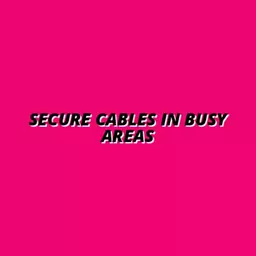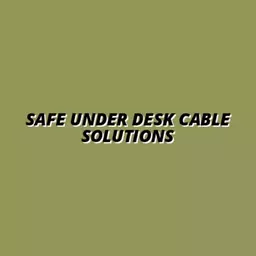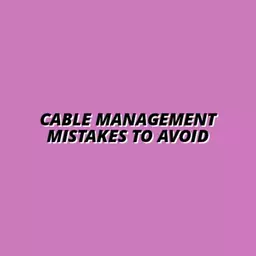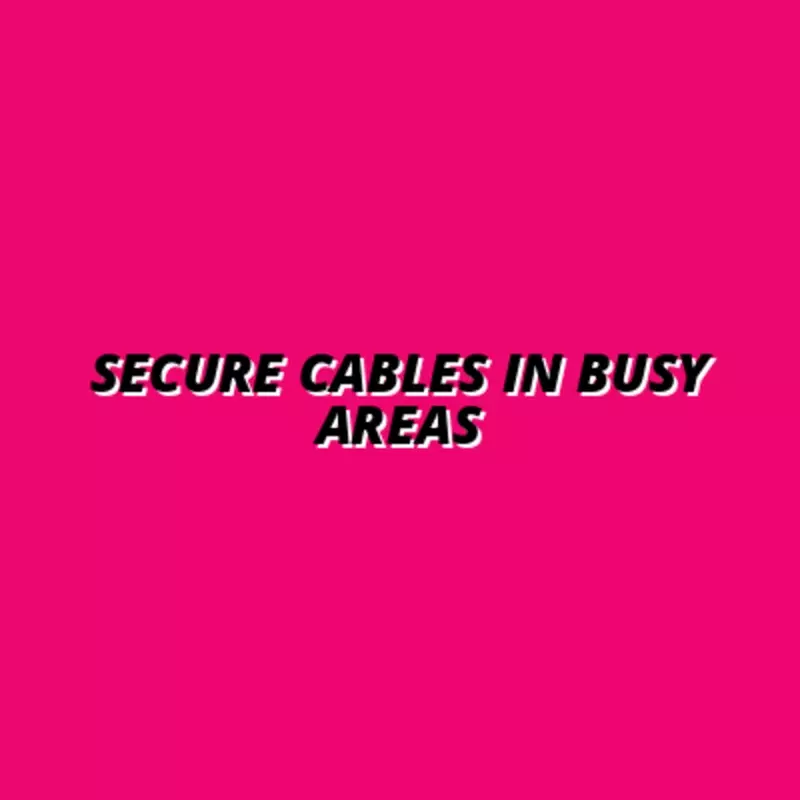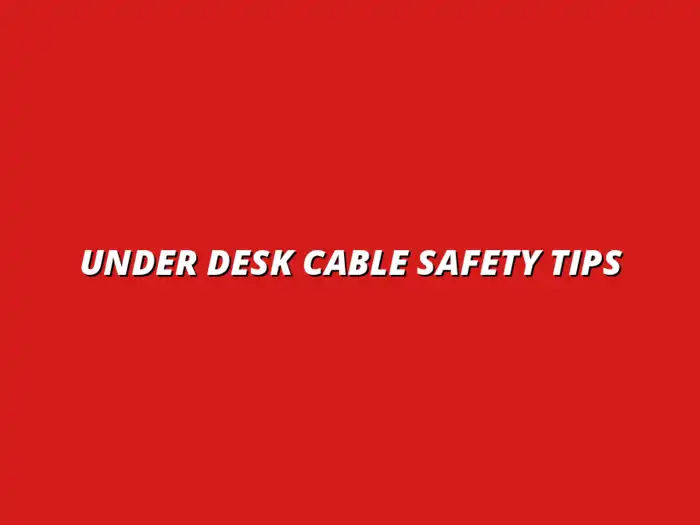
Under Desk Cable Safety Tips
Did you know that a cluttered workspace can impact your productivity by over 40%? It's time to take control of your environment and enhance safety with effective under desk cable management.
What You Will Learn
- Understanding the significance of under desk cable management for aesthetics and safety.
- Identifying common safety risks, including tripping hazards and equipment damage.
- Implementing best practices for organizing cables to minimize accidents.
- Recognizing the importance of regular cable inspections to prevent electrical hazards.
- Utilizing effective tools, such as cable trays and ties, to maintain a tidy workspace.
- Promoting a clean desk policy to enhance focus and reduce distractions.
Key Safety Risks and Organizational Strategies
Understanding the importance of cable management involves recognizing safety risks and implementing effective organizational strategies. Below is a summarized visual representation of the key points discussed.
Safety Risks
- Tripping hazards from loose cables.
- Equipment damage due to tugged cables.
- Electrical hazards from overloaded strips.
Organizational Strategies
- Use cable trays to keep cords elevated.
- Implement cable ties and wraps for organization.
- Regularly inspect and maintain all cables.
Electrical Safety Practices
- Use surge protectors with adequate ratings.
- Avoid daisy-chaining multiple power strips.
- Keep power strips accessible for emergencies.
Best Practices for Cable Maintenance
- Schedule monthly inspections of all cables.
- Replace any frayed or damaged cables immediately.
- Organize new cables as they come in to prevent clutter.
Understanding the Importance of Safe Under Desk Cable Management
When it comes to creating an efficient workspace, one vital aspect that often gets overlooked is under desk cable management. This practice involves organizing and securing cords and cables that run below your desk, which can make a world of difference. Not only does effective cable management promote a clean and tidy appearance, but it also plays a significant role in ensuring safety and functionality in your workspace.
At Tidy Workspace Hub, I want to emphasize that proper cable management is not just about aesthetics; it's about safety too! A well-organized setup can prevent accidents and damage to your equipment, thereby enhancing your productivity. Let’s explore what under desk cable management entails and why it's essential for safe work environments.
Overview of Under Desk Cable Management
So, what exactly is under desk cable management? It refers to the methods and tools used to arrange and secure cables that connect various devices to power sources and data networks. You might find that choosing from different types of cable management solutions like J-channels, raceways, and slide-out trays being used for this purpose. These solutions help in keeping your cables neatly tucked away, reducing clutter and making your workspace look more inviting.
In my experience, a tidy workspace fosters a sense of professionalism and comfort. It makes it easier to focus on the task at hand without the distraction of tangled cords. By investing some time in effective cable management, you set the stage for improved efficiency and a more enjoyable working environment.
What is Under Desk Cable Management?
Under desk cable management is about organizing the cables that power your computer, monitors, chargers, and other electronic devices. It involves the use of various tools and techniques to keep these cables out of sight—yet easily accessible. This includes using cable trays, adhesive clips, and zip ties that all work together to create a clean and safe workspace.
By keeping your cords organized, you minimize the risk of them getting snagged on your feet or causing damage to your devices. This thoughtful approach not only helps maintain a visually appealing setting but also contributes to a more functional workspace.
Why Safety Matters in Cable Management
Ensuring safety in cable management is crucial for several reasons. First and foremost, tangled and cluttered cables can create serious hazards, such as tripping or electrical shocks. Imagine trying to navigate your workspace only to trip over a mess of cords! Not only is this uncomfortable, but it can also lead to injuries.
Additionally, poorly managed cables can lead to equipment damage. Loose cables may be yanked or pulled, causing connectors to wear out over time. Implementing safe cable management practices helps protect your valuable devices and avoids unexpected repair costs! Remember, the goal of Tidy Workspace Hub is to empower you to achieve a safe and organized environment.
💡 Want to master under-desk cable trays? Start with our foundational guide to all things cable management. 👉 Read the Cable Management 101 Guide
Identifying Common Safety Risks in Cable Management
Recognizing potential safety risks is key to effective cable management. Below, we dive into some common safety issues you might encounter and how to tackle them. By being proactive, you can ensure that your workspace remains not just organized, but also safe!
Recognizing Tripping Hazards
One of the most significant risks in under desk cable management is the dreaded tripping hazard. When cables are left lying around, they can easily become obstacles, leading to falls or accidents. This is especially concerning in busy work environments where multiple people are moving about. It’s essential to take a closer look at your workspace and identify any areas where cables might pose a risk.
To minimize tripping risks, there are several strategies you can implement:
- Use cable management trays to keep cords off the floor.
- Secure cables with clips or ties to maintain a neat appearance.
- Consider using floor cable covers to keep them out of the way.
How Cluttered Cables Can Cause Accidents
Cluttered cables not only look unprofessional but can also lead to serious accidents. If cords are strewn about, they can easily catch a shoe or foot, leading to falls that could result in injury. For a smoother, safer workspace, it’s crucial to address these cable messes promptly.
By removing unnecessary cables and utilizing effective management strategies, you can create an environment that prioritizes safety. Always keep in mind that a little effort in cable organization can go a long way.
Solutions to Minimize Tripping Risks
Now that we know the dangers of cluttered cables, let’s focus on practical solutions. Here are some effective methods to minimize tripping hazards in your workspace:
- Install wall-mounted cable trays to keep cables elevated.
- Use cable wraps to bundle multiple cables together.
- Arrange cords along the edges of your desk, away from foot traffic.
Assessing Equipment Damage Risks
Another critical aspect of cable management is understanding the risks of equipment damage. Loose and tangled cables can not only lead to accidents but may also cause wear and tear on your devices. It’s easy for someone to accidentally tug on a cable connected to your important tech, leading to potential damage.
Let’s explore how cables can damage your devices and what steps you can take to protect them effectively!
Understanding How Cables Can Damage Devices
Cables that are improperly managed can lead to several types of damage to your electronics, including:
- Fraying connectors that may cause connectivity issues.
- Increased wear on ports from constant pulling.
- Short circuits from damaged cables that expose wiring.
Protecting Your Equipment: Best Practices
To safeguard your equipment from potential damage, consider these best practices:
- Keep cables organized and secure to prevent pulling.
- Regularly inspect cables for wear and replace any that are damaged.
- Use cable sleeves or covers to protect vulnerable areas.
Ensuring Electrical Safety
Electrical safety is paramount when it comes to under desk cable management. Managing power cords and ensuring they are safely set up can prevent dangerous situations. By understanding potential electrical hazards, you can create a safer workspace for everyone.
Let’s delve into identifying these hazards and the best practices to ensure electrical safety in your workspace!
Identifying Potential Electrical Hazards
Some common electrical hazards that can arise from poor cable management include:
- Overloaded power strips leading to overheating.
- Exposed wires from damaged cables.
- Improper use of extension cords that can lead to shock.
Safe Practices for Using Power Strips
Power strips can be lifesavers, but they require proper usage to maintain safety. Keep these guidelines in mind:
- Always use power strips with surge protectors.
- Avoid daisy-chaining multiple strips.
- Keep power strips in easily accessible areas for quick disconnects.
Understanding the Role of Surge Protectors in Safety
Surge protectors are essential in protecting your electronic devices from voltage spikes. They act as a barrier, absorbing excess energy and preventing damage. To keep your workspace safe:
- Choose surge protectors with adequate joules rating for your equipment.
- Regularly check and replace any older surge protectors.
- Ensure surge protectors are properly grounded.
At Tidy Workspace Hub, we believe that understanding these safety measures will empower you to create an organized and secure environment. By implementing these strategies, you not only enhance your workspace's safety but also promote productivity and efficiency. Ready to take your cable management to the next level? Let’s keep exploring the best practices together!
Pro Tip
Did you know that labeling your cables can save you time and frustration? By using simple labels or color-coded tags, you can easily identify which cable connects to which device. This not only makes troubleshooting easier but also ensures that you can quickly unplug and replug cables without confusion.
Summarizing Key Safety Tips for Under Desk Cable Management
As we wrap up our discussion on under desk cable management, it’s essential to remember the safety risks and organizational methods we’ve explored. Keeping your workspace free of hazards is not just about aesthetics; it's crucial for your safety and the longevity of your equipment! Let’s take a moment to recap some key points to ensure you’re fully equipped for a tidy and safe environment.
Recap of Safety Risks and Organizational Methods
We’ve identified several common safety risks associated with cable management. These include tripping hazards, equipment damage, and electrical safety concerns. Here’s a quick summary of vital safety tips to keep in mind:
- Secure loose cables to prevent tripping hazards.
- Avoid overloading power strips to enhance electrical safety.
- Regularly inspect cables for wear and tear to protect your equipment.
In addition to these safety tips, we discussed various organizational strategies that can enhance your workspace efficiency. Using cable ties, baskets, and covers are just a few methods to keep everything neat. Remember, the goal is to create a workspace that is not only functional but also free of clutter!
Frequently Asked Questions (FAQs)
- What are the primary safety risks associated with poor under desk cable management?
- The main risks include tripping hazards, equipment damage due to tugged cables, and electrical hazards from overloaded power strips.
- What tools can I use to effectively manage cables under my desk?
- Effective tools include cable trays, cable ties, cable wraps, adhesive clips, and cable sleeves.
- How often should I inspect my cables for wear and tear?
- It's recommended to schedule monthly inspections to check for frayed or damaged cables and replace them immediately.
- What are some best practices for electrical safety with power strips?
- Always use power strips with surge protectors, avoid daisy-chaining multiple strips, and keep power strips accessible for emergencies.
- Why is a clean desk policy important for workspace management?
- A clean desk policy helps reduce distractions, minimizes physical hazards, and promotes a more organized and efficient work environment.
Highlighting Essential Safety Tips
Here are some essential safety tips to keep your under desk area secure:
- Regularly check for any frayed or damaged cables.
- Use cable ties and Velcro straps to keep cables organized and out of the way.
- Implement a clean desk policy to reduce distractions and hazards.
By following these tips, you’ll be well on your way to a safe and organized workspace that boosts your productivity. At Tidy Workspace Hub, we believe that an organized environment fosters a clearer mind and enhances focus.
Organizational Strategies for Effective Workspace Management
Organizing your cables is just as vital as ensuring your workspace is safe. Here are a few strategies to consider for effective management:
- Implement cable trays and baskets to keep cords neatly contained.
- Use color-coded cables for easy identification and access.
- Incorporate cable covers for additional protection and safety.
These organizational methods not only make your workspace look better, but they also help in maintaining a safe working environment. With the right tools and a bit of creativity, you can truly transform your under-desk chaos into a tidy sanctuary!
Encouraging Safe Practices and Further Engagement
Staying organized is an ongoing process, and regular maintenance is key. At Tidy Workspace Hub, we encourage everyone to take a proactive approach to cable management. By routinely assessing your workspace, you can catch potential hazards before they turn into problems.
Importance of Regular Cable Management Reviews
Setting a schedule for maintenance checks can make a huge difference in keeping your workspace safe. Consider these tips for effective reviews:
- Set a reminder every month to inspect cables and connections.
- Look for signs of wear or damage and replace cables as needed.
- Organize any new cables as they come in to prevent clutter.
Regular reviews will help ensure that your workspace remains both functional and safe. Remember, a little bit of upkeep goes a long way in maintaining a productive environment!
Connecting with the Community for Shared Tips
We’d love to hear from you! Sharing your cable management experiences can inspire others in our community. Have you discovered unique solutions for keeping your cords tidy? Or perhaps you’ve faced challenges that others could learn from? Don’t hesitate to reach out and share your insights!
Engaging with our community can open new doors to innovative ideas and solutions. Together, we can make the world a more organized place, one workspace at a time!
Recap of Key Points
Here is a quick recap of the important points discussed in the article:
- Prioritize Safety: Secure loose cables to prevent tripping hazards and potential injuries.
- Avoid Equipment Damage: Regularly inspect cables for wear and tear to protect your devices from damage.
- Ensure Electrical Safety: Use power strips properly and avoid overloading them to enhance electrical safety.
- Organizational Strategies: Implement cable trays, ties, and covers to maintain a tidy workspace.
- Regular Maintenance: Schedule monthly reviews of your cable management setup to catch potential hazards early.
